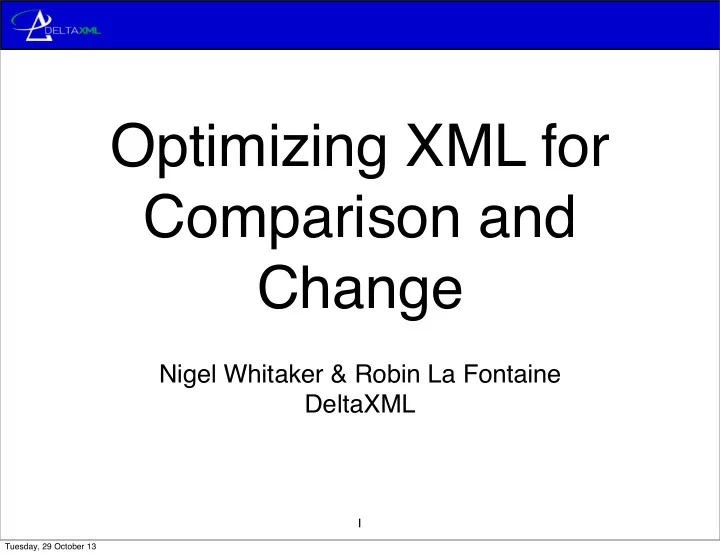

Optimizing XML for Comparison and Change Nigel Whitaker & Robin La Fontaine DeltaXML 1 Tuesday, 29 October 13
About DeltaXML • Software company based in Worcestershire, UK • First XML comparison product: 2002 • Comparison engine, toolkit, format specific products, n-way merge • Primarily a product company, provide support & consultancy 2 Tuesday, 29 October 13
About the talk/paper • Based on support experiences; Why didn’t they do it this way... • Audience: XML developers, schema designers, XML users/authors • Covering XML documents and data • Discuss our software, but applicable to other comparison and XML processing more generally 3 Tuesday, 29 October 13
Overview 1. Whitespace 2. Mixing Ordered and Unordered Content 3. Representing Change 4. Format Flattening 4 Tuesday, 29 October 13
Whitespace 1 • We see more issues with data than documents • “DTDs aren’t needed because we’re reading and writing” - private communication • “Tools should strip out whitespace”, yes, but it requires user intervention and isn’t as good as a parser 5 Tuesday, 29 October 13
Whitespace 2 <contact> ... <phone type="work"> <countryCode>44</countryCode> <areaCode>020</areaCode> <local>7234 5678</local> </phone> </contact> 6 Tuesday, 29 October 13
Whitespace 3 <!DOCTYPE contact SYSTEM “contact.dtd”> <contact> ... <phone type="work"> <countryCode>44</countryCode> <areaCode>020</areaCode> <local>7234 5678</local> </phone> </contact> 7 Tuesday, 29 October 13
Whitespace 4 Type Name Value Type Name Value attr type 'work' attr type work text '^J ' elem countryCode 44 elem countryCode '44' elem areaCode 020 text '^J ' elem local 7234 5678 elem areaCode '020' text '^J ' elem local '7234 5678' text '^J ' 8 Tuesday, 29 October 13
Whitespace: Suggestions • Create a DTD for your data • Relate it to the instance files where possible • xml:space - useful for post parsing space control 9 Tuesday, 29 October 13
Overview 1. Whitespace 2. Mixing Ordered and Unordered Content 3. Representing Change 4. Format Flattening 10 Tuesday, 29 October 13
Mixed Order 1 • Documents are usually ordered • Data can be ‘orderless’ • We use different algorithms: • Ordered data uses LCS dynamic programming techniques • Orderless uses hashing and maps 11 Tuesday, 29 October 13
Mixed Order 2 <contact> <name>John Smith</name> <addressLine>25 Malet Street</addressLine> <addressLine>Bloomsbury</addressLine> <addressLine>London</addressLine> <addressLine>UK</addressLine> <postcode>W1A 2AA</postcode> <phone type="office">+44 20 1234 5678</phone> <phone type="fax">+44 20 1234 5680</phone> <phone type="mobile">+44 7123 123456</phone> </contact> 12 Tuesday, 29 October 13
Mixed order <contact deltaxml:ordered=‘false’ > <name>John Smith</name> <address deltaxml:ordered=‘true’> <addressLine>25 Malet Street</addressLine> <addressLine>Bloomsbury</addressLine> <addressLine>London</addressLine> <addressLine>UK</addressLine> </address> <postcode>W1A 2AA</postcode> <phone type="office">+44 20 1234 5678</phone> <phone type="fax">+44 20 1234 5680</phone> <phone type="mobile">+44 7123 123456</phone> </contact> X Tuesday, 29 October 13
Mixed Order 3 <contact> <name>John Smith</name> <addressLine>25 Malet Street</addressLine> <addressLine>Bloomsbury</addressLine> <addressLine>London</addressLine> <addressLine>UK</addressLine> <postcode>W1A 2AA</postcode> <phones deltaxml:ordered="false"> <phone type="office">+44 20 1234 5678</phone> <phone type="fax">+44 20 1234 5680</phone> <phone type="mobile">+44 7123 123456</phone> </phones> </contact> 13 Tuesday, 29 October 13
Mixed Order: Suggestions • Don’t mix as siblings • Add some wrappers, useful for other purposes • Document processing expectations for orderless 14 Tuesday, 29 October 13
Overview 1. Whitespace 2. Mixing Ordered and Unordered Content 3. Representing Change 4. Format Flattening 15 Tuesday, 29 October 13
xml:lang • Defined in XML Spec, but why should you use it? • Use cases: profiling/filtering, but others too • Seen in HTML, Docbook, DITA, XSLT, SVG X Tuesday, 29 October 13
Segmenting text <p>Hello World</p> <p> <word>Hello</word> <space> </space> <word>world</word> <punctuation>!</punctuation> </p> X Tuesday, 29 October 13
Segmenting: implementation • Naive assumption: words are separated by spaces • Simple implementation: tokenizer, regexp • Only works for latin/western alphabets • Unicode Annex 29 is the proper way • Implemented by International Components for Unicode (icu4j.jar) • But which BreakIterator? Now we need xml:lang! X Tuesday, 29 October 13
xml:lang recommendation • Use it whenever possible: • DTD designers - put it on the root element at least • Developers please write the attributes • Remember icu4j.jar • Finding your locale: <xsl:variable name=”locale” as=”xs:string” select=”ancestor-or- self::*[@xml:lang][1]/@xml:lang”/> X Tuesday, 29 October 13
xml:lang X Tuesday, 29 October 13
Representing Change 1 • XML Generic formats • Comparator specific formats: deltaV2 • Track-changes: editor specific, W3C Community Group • Language Specific: • HTML: <ins/>, <del/> • DITA: @status, @rev • DocBook: @revisionflag 16 Tuesday, 29 October 13
Representing Change 2 <p status="new">This topic demonstrates how status can be used</p> <title>DITA <ph status="new">Topic</ph> title</title> 17 Tuesday, 29 October 13
Representing Change 3 <p>The <xref href="http://www.w3.org/TR/2006/REC-xml-20060816/">XML Specification</xref> allows ...</p> <p>The <xref href="http://www.w3.org/TR/xml/">XML Specification</ xref> allows...</p> <p>The <xref status="new" href="http://www.w3.org/TR/2006/REC-xml-20060816/">XML Specification</xref><xref status="deleted" href="http://www.w3.org/TR/xml/">XML Specification</xref> allows...</p> 18 Tuesday, 29 October 13
Representing Change 4 <image href="bike.gif" placement="break"><alt>Two-wheeled bicycle</alt></image> ✗ <image href="bike.gif" placement="break"><alt>Two-wheeled <ph status="deleted">bicycle</ph> <ph status="new">cycle</ph></alt></image> <image href="bike.gif" placement="break"> ✗ <alt status="deleted">Two-wheeled bicycle</alt> <alt status="new">Two-wheeled cycle</alt> </image> <image status="deleted" href="bike.gif" placement="break"><alt>Two-wheeled bicycle</ alt></image> <image status="new" href="bike.gif" placement="break"><alt>Two-wheeled cycle</alt></ ✔ image> 19 Tuesday, 29 October 13
Representing Change: Suggestions • Built-in support for change - consider using it • Ideally provide consistency for text() also allow a simple wrapper element • Use repetition (*, +) unless good reason not to 20 Tuesday, 29 October 13
Overview 1. Whitespace 2. Mixing Ordered and Unordered Content 3. Representing Change 4. Format Flattening 21 Tuesday, 29 October 13
Format flattening 1 • Document users care about words, not XML centric view • But formatting has semantics too <p>Hello XML London attendees!</p> <p><b>Hello</b> XML London attendees!</p> 22 Tuesday, 29 October 13
Format Flattening 2 <p> <b-start/> <word>Hello</word> <b-end/> <space> </space> <word>XMLLondon</word> <space> </space> <word>attendees</word> </p> 23 Tuesday, 29 October 13
Format Flattening 3 • Removability: can you remove the formatting element leaving a valid result? The content model of a <span> is the same as that of the places where a <span> is used. • Nestability: can the formatting element contain an immediate child of the same type? A <span> can directly contain another <span>. <b><i>word</i></b> vs <i><b>word</b></i> 24 Tuesday, 29 October 13
Recommend
More recommend